A Real-Life Superwoman
The Hardships, Tragedies, and Challenges of Women in Rural Costa Rica
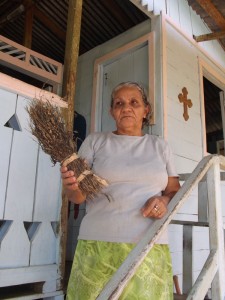
by Jack Ewing
How many women do you know in their early 60s who have given birth to thirteen children, most of them at home, and without the assistance of a mid-wife? Eleven of this woman’s children are still living and have, up until April 2013, given her 15 grandsons and 11 granddaughters, who in turn, have given her one great-granddaughter. In spite of having lived through years of hardship that most women can barely imagine Doña Porfiria Gómez carries her 64 years well. My impression was that of a mature, self-confident woman who looks upon her family as her reward for a lifetime of sacrifice and perseverance.
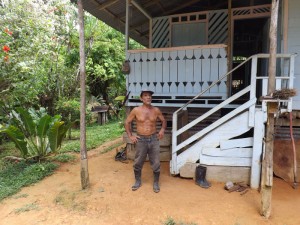
Her humble home is located in San Miguel de Aguirre, seven kilometers from the nearest place where a person can buy a bag of rice or a bar of soap. For the last 15 years she has lived in a real house with a tin roof and wooden floors, where previously she had known only thatch-roofed structures with dirt floors. Her husband, Don José, with the help of some neighbors, built the house. The only power equipment used in its construction was a chain saw to mill the boards. Everything else was done with hand tools.
She proudly showed me their solar electrical system which generated enough electricity during the day to power three light bulbs at night and enough energy left over to charge her cell phone. Incidentally the Costa Rican Electrical Institute (ICE) installed this system about ten years ago, and charges only 1000 colones ($2) a month. She said that two years ago ICE had promised them a regular electrical hook-up within a year. “It’s now been two years,” she said. “When they told us a year we figured it would be three.”
“We’ve always been poor,” she told me, with no trace of regret or complaint. “I was born in Guanacaste. My mother wasn’t married, and we didn’t have a house of our own. A man let us stay in a rancho on the condition that my mother take care of his pigs. She agreed to the deal, but told the señor that if el tigre (the jaguar) came to eat the pigs, she wasn’t going to defend them. That rancho had a thatched roof and walls made from the bark of a soft-wooded tree. At night we slept in a loft and locked up the pigs in a pen under the house. The ladder to the loft was made so that after we climbed up we could pull the steps up after us. That way el tigre couldn’t climb up and get us. We were lucky. He never came.”
“I never had a chance to go to school, and never learned to read or do numbers. All I ever did was work. We had to carry water for the house from the creek in buckets and go there to wash clothes and bathe. There was no place to buy detergent and even if there had been, we had no money to pay for it. We used crushed papaya leaves for soap. When you soak the leaves in water and rub the clothes with them they foam.” Doña Porfiria went on to explain that they made their own tableware with clay. They molded a mixture of wet clay and fine sand with their hands into the shape of a bowl, set it in the fire and covered it with coals. More than half of the bowls broke. The ones that endured the fire they kept or sold.
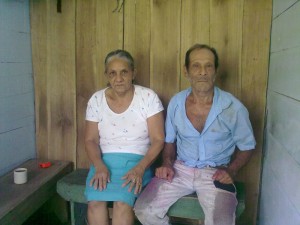
One month after her fourteenth birthday Porfiria Margarita Gómez married José Artávia Jiménez, nine years her senior. There was no work where they lived in Guanacaste so the newlywed couple decided to move away and start a new life somewhere else. José had a brother-in-law who had some land in a place called San Miguel south of Quepos so that’s where they decided to go. They set off with the few items they could call their own, all of which they carried on their backs. Neither of them even owned a pair of shoes. It took three hours to walk to Jicarál where they boarded a wooden boat made from a hollowed out tree trunk. The boat ride took them to Puntarenas where they stayed the night, though they weren’t able to sleep much. Very early the next morning they boarded another boat for an eight-hour ride to Quepos, and from there went by bus as far as the Savegre river. They walked across the suspension bridge, which was limited to light vehicles and foot traffic. They walked and caught rides as best they could on the rough and rutted road from Savegre to Hatillo, 12 kilometers. The three weary travelers walked the last seven kilometers on a horse trail that led to San Miguel. They had reached the place where they would live to this day. To appreciate the enormity of this trip we need to reflect on the psychological trauma that young Porfiria must have endured. Here was an adolescent girl, recently married , who said good-bye to the only family she had ever known not knowing if she would ever see them again, left with her new husband, and walked and rode for two days to a strange place in hopes of finding a better life. What must have been going through her mind?
Though the young couple had arrived at the place where they would make their home, the challenge ahead of them seemed insurmountable. They had no place to live, no place to build a hut, and no money. They moved into a small rancho with José’s brother-in-law, Eladio Céspedes and his family. José was young, strong, and a good worker and found occasional work with several different land owners around San Miguel, all of whom had come from elsewhere in years past and had experienced difficulties similar to his own. He helped Eladio plant corn, beans, and plantains. The young couple got to know their neighbors and came to like the area. One day a neighbor named Rafael Céspedes offered to sell José seven manzanas (12 acres) of land for 300 colones.
“I’d love to own the land Don Raphael, but where am I going to get 300 colones,” shrugged José.
“Don’t worry about the money,” replied Raphael. “Pay me when you can.” They shook hands on the deal, and, after that, whenever José had 5 colones to spare he made a payment.
With his brother-in-law Eladio’s help José began building a place for the young couple to stay. That first home was a one-room pole structure with an earthen floor. The walls were made from boards of balsa wood and milled with a long bladed hand saw with a handle on each end. It took two men to push and pull the saw back and forth. The roof was made with the broad leaves of the salt plant. It wasn’t much, but it was theirs.
I asked about mattresses.
“Mattresses? The only mattresses we knew for years were nothing more than a couple of balsa boards shoved together. If we were lucky we had a piece of cloth to put over the boards so we wouldn’t get splinters.”
“What about clothes,” I asked?
“I’ve never had a sewing machine,” replied Doña Porfiria. “I made all of our clothes by hand with a needle and thread. We bought cloth in Quepos or San Isidro and I made everything we wore.”
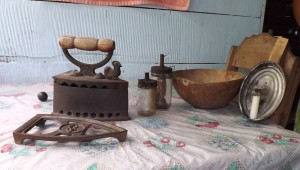
She showed me the iron that she uses to this day to iron clothes. It is shaped like an electrical iron but bigger and has a lid. Coals from the cooking fire go inside of the iron. She sprinkles the clothes with a little water, passes the iron over them, and shirts, trousers, and undergarments come out just nicely as if ironed with a modern day steam iron. Before they had electrical lights from the solar panal their only lighting came from kerosene lamps they made at home with a glass jar, a cotton wick, and a spout. It burned with a small flame at the top of the spout, much like that of a candle. Their flashlight consists of an empty, oblong, sardine can as a reflector with a candle inside and a stick for a handle. They still use these sources of light when the solar system isn’t working. Bowls and spoons were the only eating utensils. Today they have ceramic bowls, and metal spoons, but up until recently they used the shells of the jícaro fruit for both. Though she now has a store-bought broom, Doña Porfiria still keeps a broom like the ones she used for years, made from brushy plants. In the past she used the seeds from the Guanacaste tree as detergent. Clorox, disinfectant, and scrub pads were things she had heard of but never used until recent years.
Doña Porfiria served us home-grown coffee from some coffee trees she grows near the house. “First you pick the coffee,” she explained. “Then you have to dry it in the sun and shell it in the pilón” (A big, heavy, wooden bowl carved into a trunk of wood.) She showed me how they put the coffee beans in the pilón and pound them with a big blunt piece of wood called a mano. The beans then have to be toasted and ground. The ground coffee is placed in a tightly-woven cloth bag, and hot water is poured into the bag over the coffee. It streams into coffee pot placed beneath the bag. The coffee was delicious.
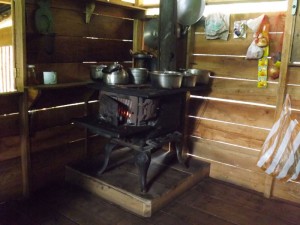
“For years we cooked with a fogón, but now I have a nice wood-burning stove.” She proudly showed me the cast iron stove located in a corner of the kitchen with a pipe extending up through the roof, carrying the smoke out of the house.
There is a high incidence of lung cancer among rural women in Costa Rica from years of inhaling smoke from the fogón, an open fire built in an elevated wooden box filled with earth, sand, or concrete. However, Doña Porfiria assured me that she doesn’t have any lung problems.
Doña Porfiria’s first child was born in their first home several months after they moved in. When the labor pains began, she wasn’t sure what was happening, but as the pains got stronger, and her water broke, it became obvious that the baby was coming. They sent word to the nearest mid-wife, a woman named María who lived a good distance away and had to come on horseback. By the time María arrived it was almost too late. She took one look at the expectant mother, smiled, placed her hand on Porfiria’s swollen belly, and the baby was born, a healthy young boy. They named him Miguel Angel. Three months and eleven days later Miguel Angel died at home from gastro-intestinal problems. They buried him in the cemetery in Hatillo. The young couple was heart-broken, but before long Porfiria became pregnant with their second child, another boy. This time they didn’t bother to call the mid-wife. María had explained what needed to be done, and José did it. Porfiria, of course, did 99% of the work.
By the time she had five children running around the house, the Health Ministry opened a basic rural clinic in Matapalo. Doña Porfiria had managed to get herself and her children to the clinic on the rare occasion of a doctor’s visit. Among other things the doctor told her that she shouldn’t be having her babies at home, that this posed a grave danger to her health, and that she could die during child-birth. She took the doctor’s words seriously and after completing the eighth month of her seventh pregnancy, went to stay with friends near Matapalo. Several people in Matapalo had cars and there was a good possibility of finding a ride to the hospital in Quepos. When Doña Porfiria felt the first labor pains she told her friend that she wanted to bathe. “I’m all sweaty, and I don’t want to go to the hospital like this.” After showering she told her friend “I don’t think I have time to go to the hospital. I need to lie down.” She did, and the baby was born. “After that,” she told me, “I figured that doctor didn’t know what he was talking about.” Her next four children were born at home. As roads and the availability of transportation improved, she and José decided that maybe it was time that she should have medical assistance with her births. Her last three children were born in the hospital in Quepos.
Living as they did, far from the comforts and conveniences enjoyed by most Costa Ricans, Doña Porfiria learned a great deal about the use of natural remedies for common ailments. The nearest doctor or source of medication to be found was at the hospital in Quepos. A handfull of over-the-counter medicines like aspirin and eye drops were available at the small general store in Hatillo, but nothing more. The most common health problem with the children was internal parasites such as worms and amoebas. Intestinal problems have always been the primary cause of infant mortality in Costa Rica, and, though impressive progress has been made, continue to be so today. Learning how to deal with intestinal problems and parasites was an absolute necessity for raising kids in San Miguel.
Once a year a representative from the health department visited the family, vaccinated the children for childhood diseases, and distributed medicine for dysentery and parasites. “That worm medicine from the health department never worked,” she told me. “I always gave the kids a tea I made from the stem of the estrella plant. Make sure you cut only stem, no knots,” she emphasized. “I chopped it up and boiled it in water. You couldn’t believe the rolls of worms that came out of those kids.” She went on to explain that she used bark from the nance tree cooked together with avocado to treat gastritis in the children. Another remedy that has always been and continues to be popular in rural Costa Rica is what is called the sobada or deep massage of the lymph nodes. This is used to treat what is called el empacho, a term used to describe an uneasiness in the stomach that keeps on for days and won’t go away.
In March of 2013 Doña Porfiria and Don Jose celebrated their 50th wedding anniversary. This is ironic because in this day and age many people would be horrified at the thought of a 14-year-old girl marrying a 23-year-old man. Yet in the rural Costa Rica of 1963 their marriage was not considered unusual. When I was with them they laughed and teased each other and were obviously a happy couple. Tell me dear reader how many couples do you know who have been happily married for 50 years?
Today many things have changed in the nearby communities, but life is much the same for Doña Porfiria and Don José. In spite of all the hardship this life has brought them I never detected the slightest indication that they considered themselves to be victims of poverty or that life had dealt them a lousy hand; rather they were thankful for their good health, the roof over their heads, the food in their stomachs, and above all the health and prosperity of their extensive family.
The most amazing thing about this story is that only the details are unique. Many rural Costa Rican women have lived equally difficult lives with the same hardships, tragedies and challenges.

